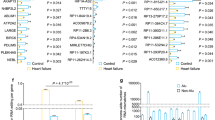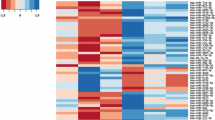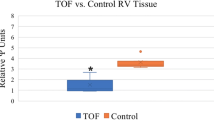Abstract
Purpose
To test the hypothesis that RNA editing is altered in pediatric patients with cyanotic congenital heart disease (CHD) and to determine whether A-to-I RNA editing is associated with the postoperative course following cardiac surgery. Cyanotic CHD is associated with a unique pathophysiology caused by chronic hypoxia. The perioperative course of cyanotic infants is partly dictated by the degree of expression of inflammatory and cardiac genes, some of which undergo A-to-I RNA editing.
Methods
RNA was extracted pre- and postoperatively from blood samples of cyanotic and acyanotic patients. Each sample was analyzed for A-to-I RNA editing using automatic DNA sequencing of an intronic segment of the MED13 gene. RNA expression levels of adenosine deaminase acting on RNA (ADAR) enzymes responsible for RNA editing were examined by quantitative reverse-transcriptase polymerase chain reaction.
Results
A-to-I RNA editing in MED13 was significantly higher among cyanotic patients (n = 19) than acyanotic ones (n = 18) both pre- and postoperatively, as manifested by average editing at seven highly edited sites (27.4 ± 8.5% versus 20.8 ± 10.2%; P = 0.038) and editing at specific sites, e.g., position 14 (20.2 ± 5.1% versus 14.5 ± 5.2%; P = 0.002). Cyanotic patients exhibited a more complicated postoperative course than acyanotic patients. ADAR2 RNA levels were significantly lower among cyanotic patients.
Conclusions
Cyanotic children manifest significantly higher rates of A-to-I RNA editing than acyanotic children as well as a more complicated surgical course. Posttranscriptional RNA changes may affect cellular and metabolic pathways and influence the perioperative course following hypoxia.



Similar content being viewed by others
References
Nevo-Caspi Y, Amariglio N, Rechavi G, Paret G (2011) A-to-I RNA editing is induced upon Hypoxia. Shock 35(6):585–589
Bass BL (2002) RNA editing by adenosine deaminases that act on RNA. Annu Rev Biochem 71:817–846
Levanon EY, Eisenberg E, Yelin R, Nemzer S, Hallegger M, Shemesh R, Fligelman ZY, Shoshan A, Pollock SR, Sztybel D, Olshansky M, Rechavi G, Jantsch MF (2004) Systematic identification of abundant A-to-I editing sites in the human transcriptome. Nat Biotechnol 22:1001–1005
Levanon EY, Hallegger M, Kinar Y, Shemesh R, Djinovic-Carugo K, Rechavi G, Jantsch MF, Eisenberg E (2005) Evolutionarily conserved human targets of adenosine to inosine RNA editing. Nucleic Acids Res 33:1162–1168
Keegan LP, Leroy A, Sproul D, O’Connell MA (2004) Adenosine deaminases acting on RNA (ADARs): RNA-editing enzymes. Genome Biol 5:209
Riedmann EM, Schopoff S, Hartner JC, Jantsch MF (2008) Specificity of ADAR-mediated RNA editing in newly identified targets. RNA 14:1110–1118
Hartner JC, Schmittwolf C, Kispert A, Muller AM, Higuchi M, Seeburg PH (2004) Liver disintegration in the mouse embryo caused by deficiency in the RNA-editing enzyme ADAR1. J Biol Chem 279:4894–4902
Tonkin LA, Saccomanno L, Morse DP, Brodigan T, Krause M, Bass BL (2002) RNA editing by ADARs is important for normal behavior in Caenorhabditis elegans. EMBO J 21:6025–6035
Brusa R, Zimmermann F, Koh DS, Feldmeyer D, Gass P, Seeburg PH, Sprengel R (1995) Early-onset epilepsy and postnatal lethality associated with an editing-deficient GluR-B allele in mice. Science 270:1677–1680
Gurevich I, Tamir H, Arango V, Dwork AJ, Mann JJ, Schmauss C (2002) Altered editing of serotonin 2C receptor pre-mRNA in the prefrontal cortex of depressed suicide victims. Neuron 34:349–356
Kawahara Y, Ito K, Sun H, Aizawa H, Kanazawa I, Kwak S (2004) Glutamate receptors: RNA editing and death of motor neurons. Nature 427:801
Laxminarayana D, O’Rourke KS, Maas S, Olorenshaw I (2007) Altered editing in RNA editing adenosine deaminase ADAR2 gene transcripts of systemic lupus erythematosus T lymphocytes. Immunology 121:359–369
Maas S, Patt S, Schrey M, Rich A (2001) Underediting of glutamate receptor GluR-B mRNA in malignant gliomas. Proc Natl Acad Sci USA 98:14687–14692
Miyamura Y, Suzuki T, Kono M, Inagaki K, Ito S, Suzuki N, Tomita Y (2003) Mutations of the RNA-specific adenosine deaminase gene (DSRAD) are involved in dyschromatosis symmetrica hereditaria. Am J Hum Genet 73:693–699
Yang JH, Luo X, Nie Y, Su Y, Zhao Q, Kabir K, Zhang D, Rabinovici R (2003) Widespread inosine-containing mRNA in lymphocytes regulated by ADAR1 in response to inflammation. Immunology 109:15–23
Peng PL, Zhong X, Tu W, Soundarapandian MM, Molner P, Zhu D, Lau L, Liu S, Liu F, Lu Y (2006) ADAR2-dependent RNA editing of AMPA receptor subunit GluR2 determines vulnerability of neurons in forebrain ischemia. Neuron 49:719–733
van Rooij E, Sutherland LB, Qi X, Richardson JA, Hill J, Olson EN (2007) Control of stress-dependent cardiac growth and gene expression by a microRNA. Science 316:575–579
Paz N, Levanon EY, Amariglio N, Heimberger AB, Ram Z, Constantini S, Barbash ZS, Adamsky K, Safran M, Hirschberg A, Krupsky M, Ben-Dov I, Cazacu S, Mikkelsen T, Brodie C, Eisenberg E, Rechavi G (2007) Altered adenosine-to-inosine RNA editing in human cancer. Genome Res 17:1586–1595
Vandesompele J, De Preter K, Pattyn F, Poppe B, Van Roy N, De Paepe A, Speleman F (2002) Accurate normalization of real-time quantitative RT-PCR data by geometric averaging of multiple internal control genes. Genome Biol 3:RESEARCH0034
Andersen CL, Jensen JL, Orntoft TF (2004) Normalization of real-time quantitative reverse transcription-PCR data: a model-based variance estimation approach to identify genes suited for normalization, applied to bladder and colon cancer data sets. Cancer Res 64:5245–5250
Rhodes JF, Blaufox AD, Seiden HS, Asnes JD, Gross RP, Rhodes JP, Griepp RB, Rossi AF (1999) Cardiac arrest in infants after congenital heart surgery. Circulation 100:II194–II199
Lipshultz SE, Wilkinson JD, Messiah SE, Miller TL (2009) Clinical research directions in pediatric cardiology. Curr Opin Pediatr 21:585–593
Chen LL, Carmichael GG (2008) Gene regulation by SINES and inosines: biological consequences of A-to-I editing of Alu element inverted repeats. Cell Cycle 7:3294–3301
Essop MF (2007) Cardiac metabolic adaptations in response to chronic hypoxia. J Physiol 584:715–726
Kim DD, Kim TT, Walsh T, Kobayashi Y, Matise TC, Buyske S, Gabriel A (2004) Widespread RNA editing of embedded Alu elements in the human transcriptome. Genome Res 14:1719–1725
Michiels C (2004) Physiological and pathological responses to hypoxia. Am J Pathol 164:1875–1882
Ma E, Gu XQ, Wu X, Xu T, Haddad GG (2001) Mutation in pre-mRNA adenosine deaminase markedly attenuates neuronal tolerance to O2 deprivation in Drosophila melanogaster. J Clin Invest 107:685–693
Dawson TR, Sansam CL, Emeson RB (2004) Structure and sequence determinants required for the RNA editing of ADAR2 substrates. J Biol Chem 279:4941–4951
Acknowledgments
The authors acknowledge financial support from departmental funding of the Sheba Cancer Research Center, and editorial assistance by Esther Eshkol.
Author information
Authors and Affiliations
Corresponding author
Additional information
S. Borik and A.J. Simon contributed equally to this work.
Rights and permissions
About this article
Cite this article
Borik, S., Simon, A.J., Nevo-Caspi, Y. et al. Increased RNA editing in children with cyanotic congenital heart disease. Intensive Care Med 37, 1664–1671 (2011). https://doi.org/10.1007/s00134-011-2296-z
Received:
Accepted:
Published:
Issue Date:
DOI: https://doi.org/10.1007/s00134-011-2296-z




